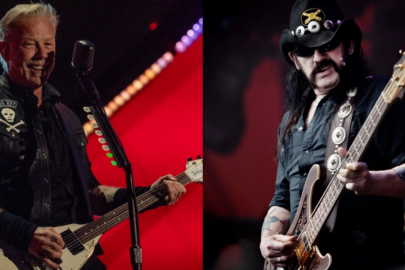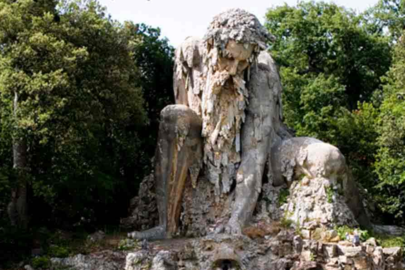Steven Soderbergh is showing me a collage he’s been making. Half-finished, it sits on a table in his New York office. Composed entirely of movie stars in character, the work gives pride of place to Robert De Niro as a mohawked Travis Bickle in Taxi Driver. He’s flanked by River Phoenix, John Belushi, Sacha Baron Cohen, Dennis Hopper and Catherine Deneuve. Further afield we have Jack Nicholson, Keanu Reeves and Sharon Stone.
Soderbergh started making collages a few years ago: bored with his library of film books, he simply started cutting them up. “It’s problem-solving,” he says. “You pull an image out. You start looking around. Where could this go? Does it need to be cut to fit? It’s hard not to take a trip through your personal experience of cinema – because all these associations just sort of collide.”
The collages could easily be a metaphor for Soderbergh’s films, with their elegant angles, cool modernist surfaces and satisfying puzzle-solver’s click. But they are also slightly demented, the kind of thing you might get if you locked one of the US’s greatest directors in a room with nothing but his library books.
Perhaps it’s a product of his retirement. In 2013, Soderbergh announced that he was putting film-making aside to take up oil painting. Three months into it, he was sent the script for medical drama The Knick and ended up directing two seasons of it for Cinemax. Then he helped Michael Douglas win an Emmy and a Golden Globe by directing him in the Liberace biopic Behind the Candelabra, before coming on board Magic Mike XXL as producer, cameraman and editor – which is about as close to directing as you can get. Then, he says, a friend sent him a script for a movie she had written, asking for possible directors.
“I read it and I could see it in my mind immediately,” he says. “Just thinking about somebody else doing it – I was getting a little jealous.” Rumour has it that Soderbergh actually wrote the script himself, under an assumed name. He says not, although he has done pseudonymous work on his own films in the past. Either way, Logan Lucky is another heist film to add to the 54-year-old’s collection, this time about two brothers (played by Channing Tatum and Adam Driver) who decide to rob the Charlotte Motor Speedway in North Carolina. Think of it as a grungy, inbred cousin to his three Ocean’s Eleven movies, shot in deepest Trumpland, with casinos and cut diamonds swapped out for Kentucky-fried accents, rhinestones and Nascar.
“I like the idea of trading the Armani in for Carhartt,” says Soderbergh. “That seemed like a fun swap. The Ocean’s movies were odes to camaraderie and professionalism. But they are kind of gossamer – they’re champagne, they fizz away and then they’re gone. I felt this had a little more of an undertow. It was a little more rooted in the real world.”
He had also been looking for a project to test a new production model he had been knocking around with Dan Fellman, who used to run Warner Bros and now heads Soderbergh’s production company, Fingerprint. They wanted to bypass the massive marketing budgets that had made studio film-making so ruinously expensive, having hit upon the idea of using foreign rights to finance production costs, and ancillary rights – HBO, Netflix, video on demand, TV replays – to pay for a much more micro-targeted campaign. Voilà! An indie film that looks, walks and talks like a studio film, but with nearly half the box office going to Soderbergh and his creative partners. Talk about a heist.
“Look, I’ve been annoyingly vocal about my issues with the studios, both creatively and economically,” says Soderbergh. “It’s difficult for me to sit in a room and tell them how to spend their money. I much prefer to be able to say, ‘This is what we’re gonna do’ – because it’s our money. It’s put up or shut up time.”
Heists have long been favoured by low-budget operators and debutants, whether Woody Allen with Take the Money and Run, Stanley Kubrick with The Killing, Wes Anderson with Bottle Rocket, Quentin Tarantino with Reservoir Dogs or Bryan Singer with The Usual Suspects. They are audience-friendly and relatively cheap: even Logan Lucky’s biggest star – Daniel Craig, playing a bleach-blond explosives expert called Joe Bang – took a tiny fraction of his usual salary in return for a share of the profits.
“He’s the Roman candle of the piece,” says Soderbergh. “Knowing how much pressure he is under, I told him, ‘I don’t care how you look and you don’t have to do any press if you don’t want to.’ I think his sense of freedom is palpable in the film – you know, not having to shoulder the whole thing. It seemed like he really enjoyed being able to just cut loose, tear up the screen and split.”
And his own attraction to the genre? “As a kid raised in suburban Baton Rouge, Louisiana, there was nothing in my upbringing that would push me toward being interested in caper films, but I always was. And then I realised, literally a week ago, I think it’s because heists are so much like making a film. You’re getting a gang together, there are external forces beyond your control. This may work, this may not. You could end up in movie jail. And it’s important to remember that panic has never solved anything in the history of the world. The analogies are very clear – I don’t know why it took so long for me to see what was right in front of me.”
To hear him tell it, Soderbergh’s career has been blessed with the kind of luck that would even bring a blush to the cheek of heist-master Danny Ocean. He pulled off the ultimate score by winning the Palme d’Or at 26 for his 1989 debut, Sex, Lies and Videotape, at just the time that Spike Lee, Jim Jarmusch and David Lynch were pushing the independent film movement into existence.
“I’ve been insanely lucky,” he says. “I showed up at the tail end of a bad decade of studio films with something that people responded to, I believe, because the audience had finally reached the point where they wanted to see something they felt was made by a person, that was made with somebody’s own hands, instead of something that felt like it was made by a corporation.”
He then followed up with four films, Kafka, King of the Hill, The Underneath and Schizopolis, “to sort of screw around and figure out what kind of film-maker I wanted to be”, before making a comeback with the superb Elmore Leonard adaptation Out of Sight. “You don’t get to make those kind of mistakes now. You don’t get four movies in a row that nobody sees and then still get a job. It’s impossible. And I needed those movies. If I didn’t make those four films, I couldn’t have made Out of Sight the way that I made it.
“I say to people, ‘Woody Allen can’t just leap from Annie Hall to Manhattan. He has to make Interiors in between.’ It is so much harder for young film-makers coming up now. I think the expectations are much higher. I started making and watching films seriously during a great period of American cinema in the 70s. I’ve been able to stand on the shoulders of all that great work.”
The comparison with Allen is a good one. Soderbergh has broken up with us several times, before seducing us again with another crowd-pleaser. “I view it the way I view sex,” he says. “If I accidentally give someone else pleasure during it, I’m fine with that.”
Che, his 2008 portrait of Che Guevara, was something of a game-changer. “When I came out the other end of it, my interest in making serious movies, important movies or award-worthy movies just disappeared completely. I suppose I could have made a sort of Michael Mann version of The Informant!, but that’s not what I wanted. I was very conscious that we turn it into a dark comedy. And Contagion, I didn’t look at as serious drama – I looked at it as a horror movie. There’s a freedom in that, in not really caring whether you’re taken seriously. I want to just be engaged by what I’m doing moment to moment. I think you can tell, when you look at Logan Lucky, that it’s made by somebody who is very engaged.”
Soderbergh will be following Logan Lucky with another horror movie: Unsane, starring Claire Foy (last seen in The Crown) and Juno Temple. He plans to shoot it in 10 days, using the same model as Logan Lucky if that works out. Meanwhile, Godless, a western for Netflix, is coming out in November, as is season two of The Girlfriend Experience, his series for the Starz network.
“Did you get much painting done?” I ask.
“No,” he says. “I was taking lessons from a painter friend, but it was going to take five years before I had something I would have shown to somebody. And when I got back to the set of The Knick, I realised nobody was waiting for my paintings. I feel very much at home on a set. This is my job.”
Source: theguardian.com































